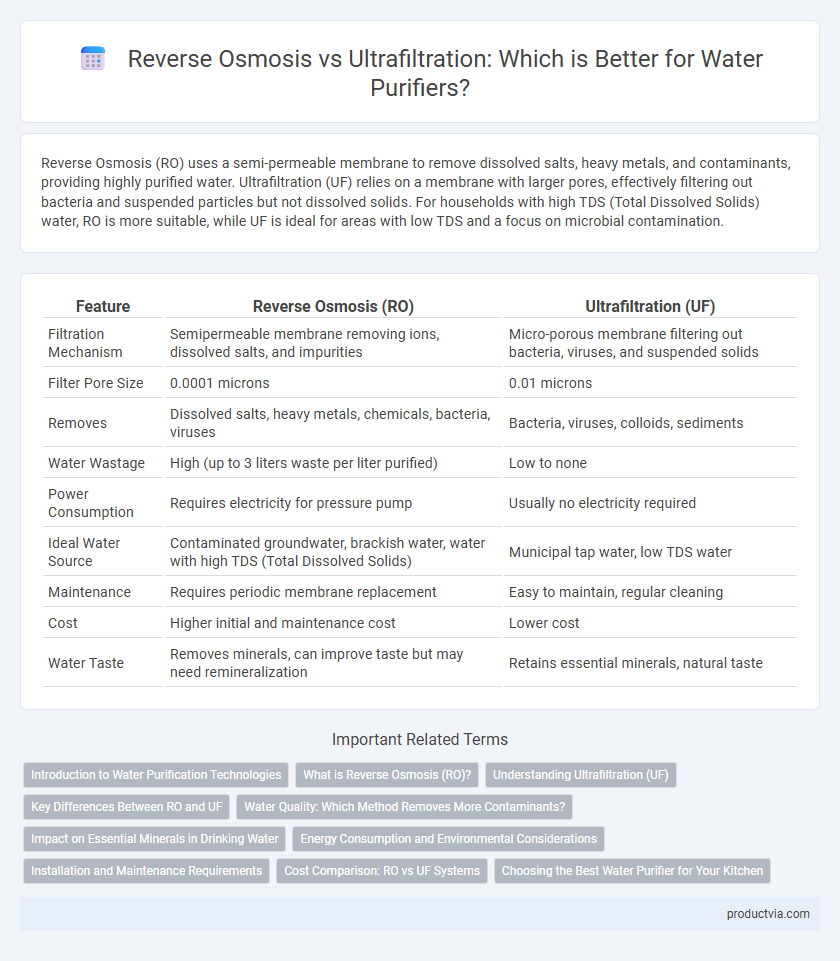Reverse Osmosis (RO) uses a semi-permeable membrane to remove dissolved salts, heavy metals, and contaminants, providing highly purified water. Ultrafiltration (UF) relies on a membrane with larger pores, effectively filtering out bacteria and suspended particles but not dissolved solids. For households with high TDS (Total Dissolved Solids) water, RO is more suitable, while UF is ideal for areas with low TDS and a focus on microbial contamination.
Table of Comparison
| Feature | Reverse Osmosis (RO) | Ultrafiltration (UF) |
|---|---|---|
| Filtration Mechanism | Semipermeable membrane removing ions, dissolved salts, and impurities | Micro-porous membrane filtering out bacteria, viruses, and suspended solids |
| Filter Pore Size | 0.0001 microns | 0.01 microns |
| Removes | Dissolved salts, heavy metals, chemicals, bacteria, viruses | Bacteria, viruses, colloids, sediments |
| Water Wastage | High (up to 3 liters waste per liter purified) | Low to none |
| Power Consumption | Requires electricity for pressure pump | Usually no electricity required |
| Ideal Water Source | Contaminated groundwater, brackish water, water with high TDS (Total Dissolved Solids) | Municipal tap water, low TDS water |
| Maintenance | Requires periodic membrane replacement | Easy to maintain, regular cleaning |
| Cost | Higher initial and maintenance cost | Lower cost |
| Water Taste | Removes minerals, can improve taste but may need remineralization | Retains essential minerals, natural taste |
Introduction to Water Purification Technologies
Reverse osmosis (RO) and ultrafiltration (UF) are advanced water purification technologies designed to remove contaminants for safe drinking water. RO utilizes a semi-permeable membrane to filter out dissolved salts, heavy metals, and microorganisms, making it effective for desalination and water softening. Ultrafiltration employs a membrane with larger pore sizes to eliminate bacteria, viruses, and suspended solids while retaining beneficial minerals, offering a balance between filtration efficiency and nutrient retention.
What is Reverse Osmosis (RO)?
Reverse Osmosis (RO) is a water purification technology that uses a semipermeable membrane to remove impurities, contaminants, and dissolved solids from water by applying pressure to force water molecules through the membrane. RO systems effectively eliminate bacteria, viruses, heavy metals, and salts, providing high-quality purified water. This process is highly efficient for desalination and producing safe drinking water in residential and industrial applications.
Understanding Ultrafiltration (UF)
Ultrafiltration (UF) uses a membrane with pore sizes ranging from 0.01 to 0.1 microns to effectively remove bacteria, viruses, and suspended solids from water without requiring high pressure. UF systems operate at lower energy consumption compared to Reverse Osmosis (RO) and retain essential minerals, making the water healthier for consumption. Ideal for municipal and surface water treatment, Ultrafiltration delivers clean, safe water while preserving taste and essential nutrients.
Key Differences Between RO and UF
Reverse Osmosis (RO) uses a semipermeable membrane to remove dissolved salts, heavy metals, and microorganisms, providing highly purified water. Ultrafiltration (UF) relies on a physical barrier with larger pores that block bacteria and suspended particles but allow dissolved minerals to pass through. RO requires higher water pressure and energy consumption, while UF operates efficiently at lower pressure with minimal maintenance.
Water Quality: Which Method Removes More Contaminants?
Reverse osmosis (RO) systems remove up to 99% of contaminants, including dissolved salts, heavy metals, and microorganisms, providing superior water quality compared to ultrafiltration (UF), which primarily filters out bacteria and suspended solids. RO membranes have pore sizes around 0.0001 microns, effectively eliminating viruses, arsenic, fluoride, and nitrates, whereas UF membranes with pore sizes between 0.01 to 0.1 microns cannot remove dissolved ions or chemicals. For comprehensive contaminant removal ensuring safe drinking water, reverse osmosis is the more effective purification method.
Impact on Essential Minerals in Drinking Water
Reverse Osmosis (RO) effectively removes a wide range of contaminants but also eliminates essential minerals like calcium and magnesium, potentially leading to mineral-deficient water. Ultrafiltration (UF) retains beneficial minerals while filtering out bacteria, viruses, and suspended particles, preserving the natural mineral content in drinking water. Choosing UF over RO can support better mineral intake without compromising water safety.
Energy Consumption and Environmental Considerations
Reverse osmosis (RO) systems typically consume more energy than ultrafiltration (UF) due to the high pressure required to force water through semipermeable membranes, resulting in greater electricity usage. Ultrafiltration operates at lower pressures and thus offers a more energy-efficient solution, making it environmentally favorable for reducing carbon footprint. In terms of environmental impact, UF produces less wastewater compared to RO, which can discard 3 to 4 liters for every liter of purified water, creating concerns over water wastage and disposal.
Installation and Maintenance Requirements
Reverse Osmosis systems require professional installation due to complex plumbing and electrical connections, while Ultrafiltration units are easier to install with minimal technical expertise. Maintenance for Reverse Osmosis involves regular membrane replacement and pre-filter changes every 6 to 12 months, whereas Ultrafiltration needs less frequent cleaning and filter replacements, typically every 12 months. Ultrafiltration systems consume less water during operation, reducing maintenance-related costs compared to Reverse Osmosis technology.
Cost Comparison: RO vs UF Systems
Reverse Osmosis (RO) systems generally have a higher initial cost and maintenance expense compared to Ultrafiltration (UF) systems due to their complex membrane technology and energy consumption. UF systems are more cost-effective for households seeking affordable, low-maintenance water purification without the need for high-pressure pumps. Long-term expenses for RO include membrane replacements and electricity bills, whereas UF primarily involves occasional filter changes with minimal operational costs.
Choosing the Best Water Purifier for Your Kitchen
Reverse osmosis purifiers use a semi-permeable membrane to remove impurities as small as 0.0001 microns, making them highly effective against dissolved salts, heavy metals, and microorganisms. Ultrafiltration systems filter particles down to 0.01 microns, efficiently eliminating bacteria and protozoa while retaining essential minerals. Selecting the best water purifier depends on water quality, with reverse osmosis ideal for areas with high TDS (total dissolved solids) and ultrafiltration suited for less contaminated sources needing mineral retention.
Reverse Osmosis vs Ultrafiltration for water purification Infographic

 productvia.com
productvia.com